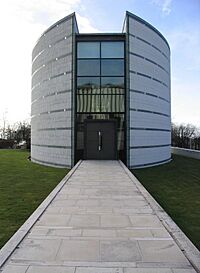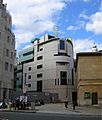Richard MacCormac facts for kids
Quick facts for kids
Sir
Richard MacCormac
CBE PPRIBA RA FRSA
|
|
|---|---|
| Born |
Richard Cornelius MacCormac
3 September 1938 Marylebone, London, England
|
| Died | 26 July 2014 (aged 75) Spitalfields, London, England
|
| Alma mater | Trinity College, Cambridge Bartlett School of Architecture, University College London |
| Occupation | Architect/university lecturer |
| Years active | 1967–2014 |
|
Notable work
|
Ruskin Library, Southwark tube station |
| Spouse(s) |
Susan Karin Landen
(m. 1964; separated 1983) |
| Partner(s) | Jocasta Innes (1983–2013; her death) |
| Children | 2 |
Sir Richard Cornelius MacCormac (born September 3, 1938 – died July 26, 2014) was a famous English modernist architect. He was known for designing many important buildings, especially for universities. Richard MacCormac also started his own architecture company, MJP Architects.
Contents
Early Life and Family
Richard MacCormac was born in Marylebone, London, England. His father, Dr. Henry MacCormac, was a skin doctor. His family had a long history of doctors in Northern Ireland. Richard's great-grandfather, also named Henry MacCormac, was a well-known doctor in the 1800s. His great-uncle, Sir William MacCormac, was even a surgeon to Queen Victoria.
Education and Career Beginnings
After serving in the Royal Navy, Richard went to Trinity College, Cambridge, where he studied very well. He then studied architecture at the Bartlett School of Architecture, which is part of University College London.
In 1972, he started his own architecture firm, which later became known as MacCormac Jamieson and Prichard (MJP Architects). He worked on different types of buildings, including homes for people in London. In 2011, he left MJP to start a new company under his own name.
Richard became famous in the 1980s for his modern designs, especially for university buildings. He won a competition to design a building for the University of Bristol. Some of his well-known university projects include:
- The Sainsbury Building for Worcester College, Oxford
- The Ruskin - Library, Museum and Research Centre at the University of Lancaster
- The Bowra Building at Wadham College, Oxford
- Burrell's Fields at Trinity College, Cambridge
- The Garden Quadrangle at St John's College, Oxford
Major Building Projects
Richard MacCormac also designed buildings for businesses and public spaces. Some of his notable projects include:
- Southwark tube station for the Jubilee Line Extension in London. This station won an award in 2000.
- The Wellcome Foundation Wing and Dana Centre at the Science Museum, London.
- A training center for Cable and Wireless in Coventry.
- A Tesco supermarket in Ludlow.
He was chosen to design the new Egton Wing for the BBC's Broadcasting House. However, the BBC asked for a cheaper design, and Richard refused to lower his quality standards. Because of this, his company was removed from the project.
In 1999, Richard designed a modern home in Hampstead for the famous football player Thierry Henry. This house was seen as a great example of modern architecture in the UK.
Richard also helped create the Phoenix Initiative in Coventry. This project aimed to combine art and architecture to improve the city center. It was even considered for a major architecture award in 2004.
Teaching and Awards
Richard MacCormac taught architecture at the University of Cambridge for many years. He was also a visiting professor at other universities, including the University of Edinburgh and the University of Hull.
He received many honors for his work:
- He became a fellow of the Royal Society of Arts in 1982.
- He was elected to the Royal Academy in 1993.
- He was made an honorary fellow of Trinity College, Cambridge, in 2006.
- He received an honorary Doctor of Science degree in 2008.
- He was awarded the CBE in 1994.
- He was made a knight in 2001, which means he could be called "Sir Richard."
Outside of work, he enjoyed music and reading. He also owned and sailed an old oyster fishing boat.
Personal Life
Richard MacCormac married Susan Karin Landen in 1964. They had two sons, William and Luke. Sadly, Luke passed away at a young age.
Later, Richard met Jocasta Innes, a well-known author. They lived together in Spitalfields, London, for many years. After Jocasta passed away in 2013, and while battling his own illness, their shared home was put up for sale.
In June 2014, Sir Richard published a book called Two Houses in Spitalfields. It was a personal story about the homes he shared with Jocasta. The money from the book was given to the Maggie's centres, which are cancer charities.
Death
Sir Richard MacCormac died on July 26, 2014, at the age of 75. He had been fighting cancer. He was buried next to Jocasta Innes in a churchyard in Laverton, Somerset.
Gallery
-
The former Cable and Wireless training centre in Coventry, now owned by Network Rail
-
Sainsbury Building for Worcester College, Oxford
-
Burrell's Field for Trinity College, Cambridge
-
Bowra Building at Wadham College, Oxford
-
The Egton Wing of the BBC's Broadcasting House
-
The Garden Quadrangle, St John's College, Oxford










